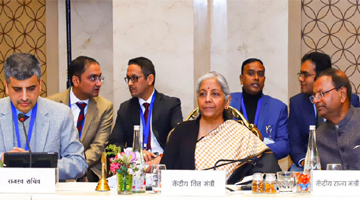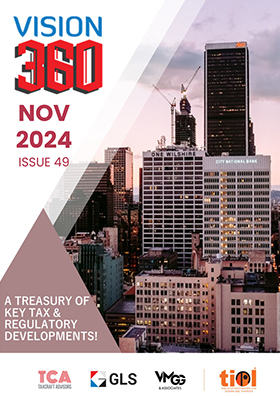APRIL 15, 2024
By M G Kodandaram, IRS, Assistant Director (Retd), ADVOCATE and CONSULTANT
 Model All India GST Audit Manual Model All India GST Audit Manual
THE primary aim of introducing GST was to create a unified national market by eliminating the significant differences and complexities in Indirect tax regime across India. However, the current GST audits conducted by authorities deviate from the promised consistent and transparent system that was assured. In a self-assessment realm, audits play a crucial role in verifying records, complementing efforts against tax evasion, develop constructive engagement with taxpayers to improve compliance. To achieve this objective, the audit methodology adopted by authorities must adhere to principles of neutrality, transparency, accountability, and sustainability, which are currently lacking in the audits conducted.
The author has discussed many non-transparent approaches and deficiencies in previous articles, providing readers with a deeper understanding. (refer SOP for GST Audit - need of the hour NOV 23, 2020; Non-uniform Implementation of Unified GST MARCH 23, 2022; Inside GST Audits: Understanding the Hurdles for Registered Taxpayer MARCH 27, 2024) An uniform and transparent adoption of best practices in audit procedures by all authorities would enable the consolidation of outcomes and their analysis for informed policy decisions, supporting GST's core objective of ensuring stable revenues for both states and the central government. Any deviation in this approach will defeat the very purpose for which premises-based audits are devised.
The GST Council Secretariat assigned a Committee of Officers, comprising officials from CBIC, states, GSTN, and the GST Council, to prepare a comprehensive All India Model GST Audit Manual enabling uniformity in conduct of audits by both the Centre and the State Authorities. Despite the substantial delays, this initiative by the GST Council must be appreciated as it signifies a positive step forward. The Model GST Audit Manual (GSTAM), published around April 2023 (hereinafter referred as 'manual' for brevity) aims to be a thorough document with a holistic approach to GST audit, assisting Audit Officers from both the Centre and the States/Union Territories, as well as benefiting auditees during audits. As stated in the foreword, the 'guidelines provided in the manual are intended to enable audit officers to carry out effective audits in a uniform, efficient and comprehensive manner adopting the best practices of the States and the Centre, as well as international practices.' The manual provides insights into audit principles and procedures, offering a comprehensive understanding of the audit process to all stake holders and users. The manual, based on the best audit practices makes 14 recommendations (see Annexure 17 of the manual) for meeting the requirement of Transparent and fair audit.
The execution of these suggestions has encountered further setbacks, leading to a deficiency in transparent procedures crucial for an effective GST Audit. The administration appears to lack the necessary enthusiasm and effort to establish a uniform audit system even after six years since GST was introduced. While the front-end activities, centered around GST Network, have seen huge improvements, the backend administration remains slow and dormant to change its approach. This article emphasizes the need for the Council to vigorously pursue certain recommendations and actions to promote a more favorable audit environment for registered entities.
Robust Feedback Mechanism
Recommendation number 9 in the GSTAM emphasizes the implementation of a robust feedback mechanism throughout the GST audit process as a vital aspect for enhancing the conduct of audits by authorities. Gathering feedback from taxpayers helps in identifying both strengths and weaknesses within the audit system, leading to ongoing enhancements. It is proposed to institutionalize feedback collection as a regular practice within the GST administrative schedule across all states. This improves audit quality and performance and identifies areas where audit capabilities can be reinforced. Overall, a well-structured feedback mechanism promotes a dynamic and effective GST audit system. However, authorities have not yet taken steps in this direction for reasons best known to them.
Would it not be prudent to establish a centralized online feedback system on the 'common goods and services tax electronic portal', which could later be shared with the relevant state and central officials? This facility would make auditees more comfortable in providing feedback on conducted audits. Additionally, it would save states in implementing this measure, ensuring uniformity across the board.
Audit Monitoring Committee
Recommendation number 10 in the manual stresses the need for an Audit Monitoring Committee (AMC) for post-audit processes. This committee is designed to review audit reports, suggest adjudication recommendations, and oversee the adjudication process so that proper timelines are followed. The review involves AMC which meets regularly to assess the sustainability and accuracy of objections raised by audit officers. Establishing an AMC in each State department helps minimize disputes and standardize audit practices. Creating an online platform for sharing audit insights and findings among different zones or divisions also promotes knowledge exchange and capacity building.
While a few states have adopted this system in non-digital formats, others have not acted. It should be noted that this mechanism is integral to ushering in transparency in audit. All authorities should be urged by the Council to implement this, before initiating any further audits.
Coordination Between State and Central Audit Officers
Recommendation 13 of the report underscores the crucial need for coordination between State and Central audit officers, especially in cases involving similar businesses. This coordination is aimed at sharing findings and outcomes, ensuring cohesive strategies and the exchange of best practices. Despite the recommendation and potential benefits, achieving seamless coordination between these officers remains a challenge in GST implementation. Essential coordination in backend processes has yet to be fully realised, raising questions about the effectiveness of existing mechanisms and the need for innovative solutions in the audit function.
One promising solution is the establishment of exclusive audit units comprising officers from both CGST and State GST departments. Such combined exclusive audit groups present a strategic approach to enhancing audit efficiency, streamlining processes, and develops collaboration between State and Central audit officers. These dedicated units would collaborate on audits, pooling expertise, and resources to ensure thorough and effective audits. This arrangement could significantly improve efficiency, reduce duplication of efforts.
Establishing a coordination cell as well as monitoring cell within the GST Council, consisting of senior officers from both levels of government, can further facilitate this coordination. This cell would promote collaborative strategies and the sharing of initiatives to strengthen collaboration and improve audit efficiency.
Incorporating Technology in Auditing
Recommendation 14 in the report emphasizes the significance of integrating technology into the audit process through the creation and deployment of E-Audit modules. The e-audit modules mark a significant shift toward digitalization in auditing, facilitating streamlined procedures, precise data capture, and enhanced reporting. Their primary aim is to introduce efficiency, transparency, and efficacy into auditing while reducing manual errors and paperwork. Key recommendations for E-Audit modules include encompassing a wide array of functions to enable senior management to generate comprehensive Management Information System (MIS) reports related to audits. This ensures that the entire audit cycle, from selection and planning to reporting, payment, closure, and adjudication, seamlessly integrates into a digital framework.
The GST Network (GSTN) has created its GST Audit Module, offering an end-to-end digital solution for the GST audit process. These E-Audit modules provide features such as risk-based selection, electronic audit assignment, digital documentation, and streamlined reporting, leading to heightened efficiency, accuracy, real-time monitoring, and transparency in auditing processes.
In this context, the Council should urge all state and central audit groups to utilize the end-to-end digital solution provided by the GST Network in order to nurture a transparent audit environment. Instead of encouraging each state to create their own tools, leveraging this existing module could be more effective. If necessary, enhancements can be made in this module to include feedback and audit monitoring activities as recommended in the report of the manual. This initiative can save time and costs, avoid duplication, while achieving the desired standardization of audit processes without further delay. The council secretariat can ensure proper supervision of audit activities across all authorities, eliminating the need for unnecessary audit-related reports as all audit activities will be available within this application.
The adoption and utilization of the E-Audit module developed by GSTN will bring higher levels of uniformity, efficiency, transparency, and effectiveness to audits, benefiting both government entities and taxpayers by promoting continuous improvement in audit practices and outcomes. It is hoped that the Council prioritizes the implementation of these recommendations in the interest of transparent and standardized audit procedures nationwide.
[The views expressed are strictly personal.]
| (DISCLAIMER : The views expressed are strictly of the author and Taxindiaonline.com doesn't necessarily subscribe to the same. Taxindiaonline.com Pvt. Ltd. is not responsible or liable for any loss or damage caused to anyone due to any interpretation, error, omission in the articles being hosted on the site) |
|









 Download PDF
Download PDF Model All India GST Audit Manual
Model All India GST Audit Manual




